

| Scholars have speculated that this work was first conceived for an altar in the Siena Duomo commissioned by Cardinal Francesco Piccolomini. At some point Michelangelo must have been persuaded to sell the sculpture to an affluent Bruges gentleman, Jan de Moscron, who in 1514 donated the work as part of a sumptuous altar to the Church of Our Lady. It is also speculated that the sculpture had originally been conceived with a lower viewing angle, which would explain the odd proportions and the downcast eyes of both Jesus and Mary. During Michelangelo's lifetime, this work was the sole sculpture by him outside of Italy although today both the Louvre and the Hermitage own works by him. | ||
The Chapel of the SacramentsMichelangelo's sculpture is in a black marble niche flanked by red-veined marble columns. The statues on each side representing Faith and Hope were executed by Pieter Pepers and added to the ensemble in the 18th century. |
||
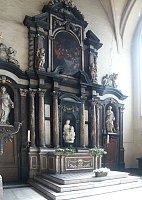
|
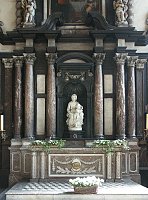
|
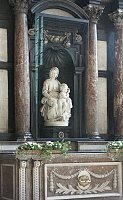
|
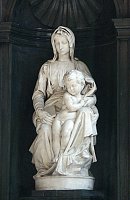
|
This early work has parallels with the St. Peter's Pietà (1497-1500) both in style and finish. Like the work in Rome, it is beautifully finished with a high polish, and the face of the Madonna is similar. (See also the whole St. Peter's Pietà as well as a detail of the Madonna's face.) In both works she has a graceful forehead and slender neck with her head positioned slightly at an angle. However, Michelangelo has already moved to less elaborate and/or fussy drapery and a greater monumentality. Here he employs the High Renaissance pyramid with the Child's body enclosed within the form of his mother, thus creating a more monumental effect. In addition, Michelangelo has designed a pose in which Jesus' arm crosses his body, a dramatic contrapposto pose used with even greater force and torsion in his later works. | |
| Like the Pietà in Rome, which was attacked by a lunatic, this work now has a bullet-proof screen in front of it. Similarly, visitors are kept at a significant distance from the sculpture, thus making careful study impossible. | ||
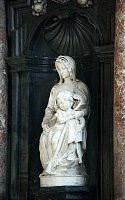
|
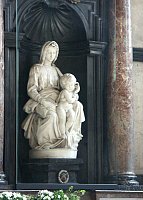
|

|
| Unlike many depictions of the Madonna and Child, this work is sober and serious. Symbolically, it illustrates the traditional idea that the Virgin was aware of her Child's tragic destiny; her pensive gaze seems to reflect this. In addition, Jesus steps down from her lap as if he too is aware of his future role. Here he seems ready to walk and to begin symbolically the journey that will lead to his Passion. | ||
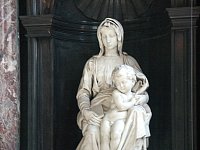
|

|
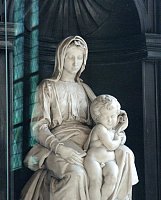
|
See Index for other works by Michelangelo.
 Click here to return to index of art historical sites.
Click here to return to index of art historical sites.
 Click here to return to index of artists and architects.
Click here to return to index of artists and architects.
 Click here to return to chronological index.
Click here to return to chronological index.
 Click here to see the home page of Bluffton University.
Click here to see the home page of Bluffton University.

